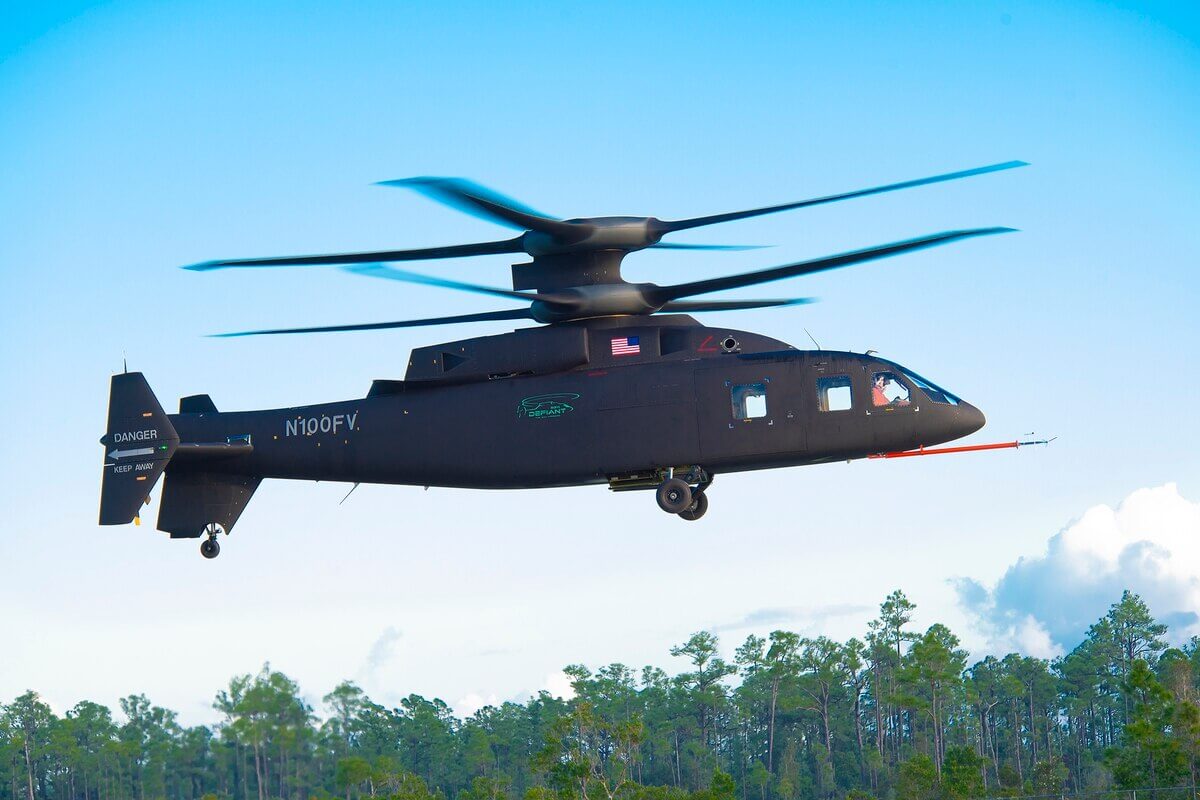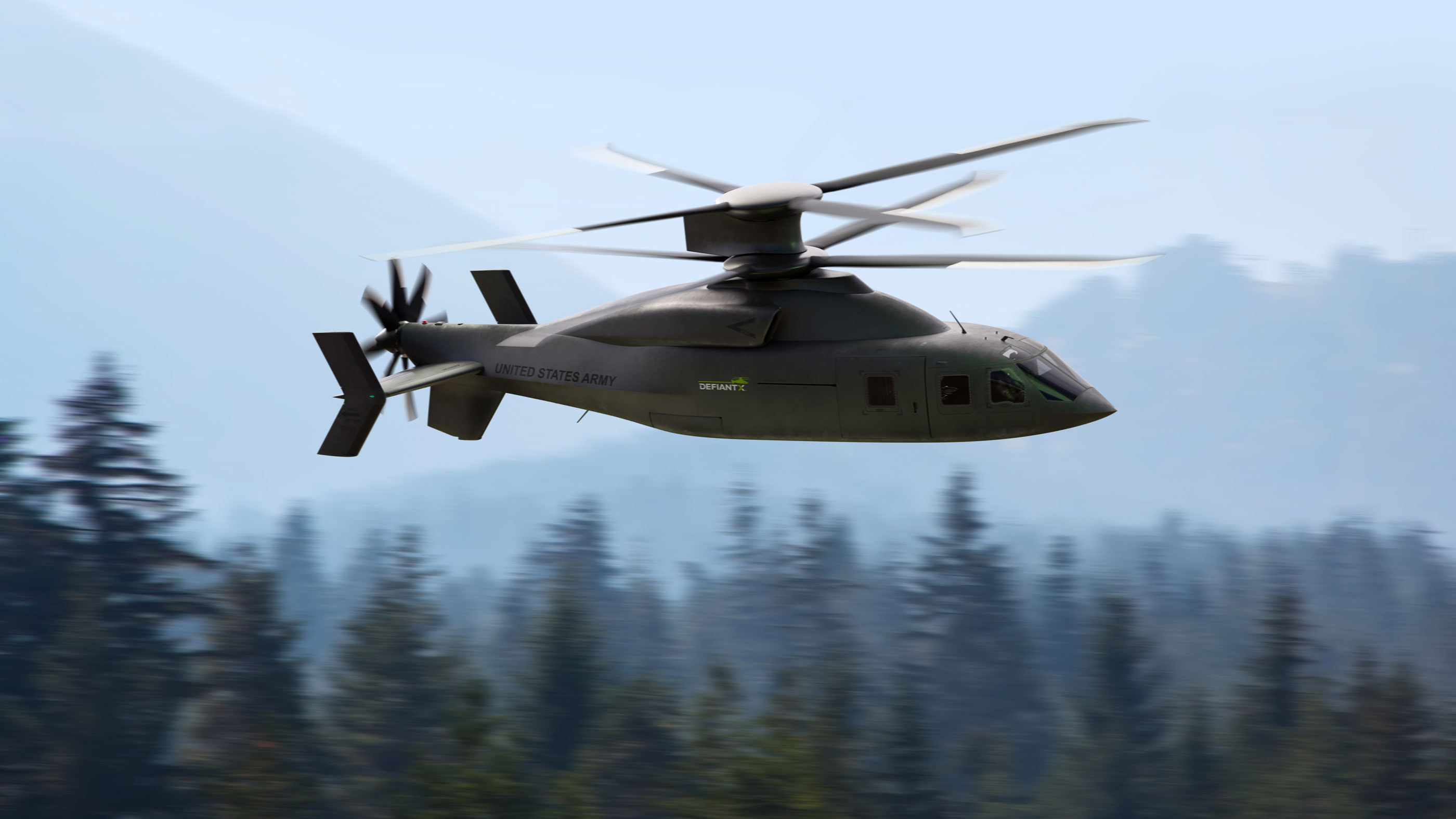Sikorsky and Boeing have unveiled a refined vision of the Defiant compound coaxial helicopter, the team’s ultimate pitch to replace the U.S. Army’s Black Hawk helicopters with a speedy Future Long Range Assault Aircraft (FLRAA).
The companies have released splashy renderings of the “Defiant X” and a video showing it performing demanding battlefield duty — cruising through forested ravines with an underslung artillery cannon, landing troops in combat formation — but were cagey with reporters about how the new design improves on the SB>1 Defiant prototype currently flying.

Images of Defiant X reveal a noticeably pointier nose cone, relocation of the engine exhaust outlet from aft of the main rotor assembly, lateral reshaping of the airframe and tail boom and chevron-style tail fins. All are enhancements to the existing design that reduce Defiant’s thermal signature and improve aerodynamic handling, according to the Defiant team.
Defiant X also has a tricycle-style landing gear with one wheel under the cockpit and two wheels aft whereas the operational protype Defiant sported two front wheels and a tail wheel that protruded down from its tail boom. The new configuration “improves stability and landing and taxiing in combat and austere environments,” according to the Defiant team.
The signature coaxial, counter-rotating main rotor system and eight-bladed aft pusher propeller configuration remain essentially unchanged, thought some refinements to the rotor hubs may have been made to enhance aerodynamic efficiency, according to Jay Macklin, Sikorsky’s director of Future Vertical Lift business development.
Changes made to the Defiant are the result of data “flowing back and forth with the Army,” Macklin said in a Jan. 22 conference call with reporters. Macklin did not divulge much about the Defiant’s redesign, except to say the “X” iteration includes speed, survivability and other “enhancements” of capabilities demonstrated by the SB>1.

“Working very closely with the Army on requirements maturation, we’ve looked to optimize our design to what the Army’s looking for and you can see different changes to the aircraft that we believe provide the best level of performance,” Macklin said. “It’s a journey that we’re on with the Army.”
None of the renderings provided by the Defiant team show weapons mounted on the aircraft.
Macklin said Defiant X is a “combat weapon system that builds on the handling qualities and transformational capability proven by all of the data that we’ve produced out of CD&RR as well as the team’s technology demonstrator.”
Heather McBryan, director of sales and marketing for Boeing’s Future Vertical Lift programs, said changes were made to the “mold line” of the aircraft and that its aerodynamics are balanced with thermal signature.
“The nose cone is a good example of what we’re doing with aerodynamics and I’m not saying that won’t change, but that’s where we are at today,” McBryan said.
“We’re really driving a purpose-built solution to not only focus on the Army’s mission, but we’re also providing provisions for growth, improved supportability and innovations for a maintenance-friendly design,” McBryan said.
Despite recent refinements, Defiant X has the same footprint as the SB>1 Defiant demonstration aircraft, which was designed to fit in the same operational footprint as the Black Hawk. Macklin would not discuss aircraft weight, but said the aircraft is “very similar” to the existing Defiant demonstration aircraft.

“As you look at a photo of this aircraft and then you look at Defiant, I mean, there are some changes, but I think what’s important is the basic configuration of the aircraft is the same,” Macklin said. “It’s important to see that this aircraft, this technology, can take these kind of design iterations without a wholesale design or significant change. It’s making the product better in conjunction with our Army partners.”
Defiant and its prime competitor — Bell’s V-280 Valor advanced tiltrotor — resulted from the Joint Multirole Technology Demonstration (JMR-TD) program the Army launched in 2013. Both teams are operating demonstration aircraft and using the data collected to refine their FLRAA pitches under competitive demonstration and risk reduction (CD&RR) contracts awarded by the Army.
Sikorsky, the incumbent manufacturer of the UH-60 and now owned by Lockheed Martin, has promised to deliver scalable compound coaxial helicopters that can dramatically improve on the performance of conventional rotorcraft. Sikorsky has so far scaled its X2 technology — the basic configuration of counter-spinning, coaxial rotors paired with a clutched aft pusher propeller — from the 10,000-pound (5,000 kilogram) S-97 Raider to the 30,000-lb. (15,000 kg) Defiant.
Defiant has logged 1,500 hours in Sikorsky’s systems integration laboratory (SIL), and 135 hours on the ground-based propulsion systems test bed (PSTB). After a rocky start, Defiant roared through a series of test milestones in 2020.
In the two years since its first flight, the demonstration aircraft has performed 31 test flights, accumulating 26 total flight hours, according to the Defiant team.With two-thirds prop torque and engine power, Defiant has achieved 211 knots in straight-and-level flight and 232 knots during a descent.
Sikorsky and Boeing can be forgiven for playing performance characteristics of their aircraft close to the vest. Not only is the FLRAA competition ongoing, but the Army has not formalized its requirements. The Army is expected to release a formal request for proposals on FLRAA later this year, with a contract award expected in 2022 for one of the two industry competitors continuing to production. First delivered of FLRAA are expected by 2030.
The Defiant team is still “evaluating” options for the two engines that will power Defiant X. The SB>1 prototype is run by two Honeywell T55 engines, the same powerplants that power the CH-47 Chinook helicopter.
The Defiant team is planning to announce a new manufacturing team that will join forces to build a militarized, production version of Defiant X. Macklin would not comment on when production of the first Defiant X needs to begin in order to meet the Army’s program schedule. He did say the current team has set up “systems and places to produce this aircraft exactly when the Army wants it.”









